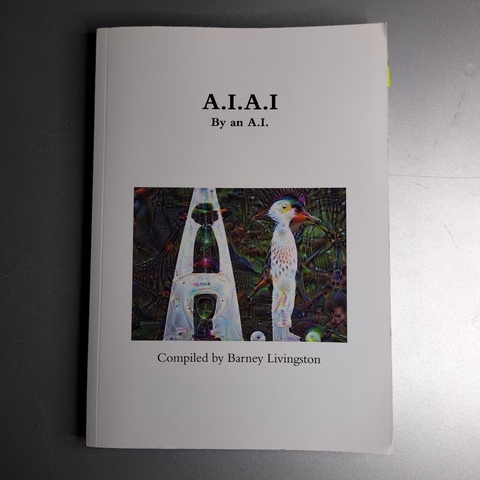For NaNoGenMo 2016 I had an idea to attempt to generate an novelisation of the film A.I. Artificial Intelligence using image captioning AI on stills from the movie.

The cover of the resulting paper copy of the novel.
Method
- I ripped the DVD of “A.I. Artificial Intelligence”.
- Then extracted 5036 stills from the file (frame rate of 0.6 per second) with Avconv.
- Using https://github.com/karpathy/neuraltalk2 I ran two passes over the images, first with sample_max set to 1, which produces more accurate captions (and more repetition), then with sample_max set to 0, which is less accurate but more “imaginative”.
- The neural network has a tendency to fail and produce the string “UNK” as part of the caption, more so with sample_max 1.
- So I loop over each line in the accurate text, if it has an “UNK” or the first five characters are the same as the previous line then replace it with the sample_max 0 text.
- Any remaining UNKs I replace from a list of synonyms of “unknown”.
- Then I build sentences from those lines, possibly combining two with a conjunction or a semicolon.
- Then I make paragraphs from multiple sentences.
- Then chapters from a bunch of paragraphs.
- The chapter titles are the most common five letter or more word in the chapter that’s not previously been a chapter title.
- I put the output into a LaTeX template from here: https://www.overleaf.com/latex/templates/fiction-novel/pjdthvgdtsfy
- Then run pdflatex to produce the PDF.
Result
An excerpt:
Chapter 11 - Looking
A bus is on standing by a very big building, and a cat is sitting on a window sill. A reflection of a man in a car mirror. A black and white cat is standing in front of a mirror, or a black cat is curled up on the hood of a car. A couple of cats are sitting on a table, yet a woman walking down a street with a dog. A man is walking a dog on a city street.
A person taking a picture of a car in the mirror. A glass of wine is sitting on a table, and a person is taking a picture of a man in a suit. A woman is taking a picture of herself in the mirror; a black and white photo of a person in a car. A person is taking a picture of a car in the snow. A cat is sitting on the hood of a car, or a man is sitting on a motorcycle in a parking lot.
A woman is sitting on a motorcycle with a dog, and a man in a suit and tie is looking at a camera. A window with a large mirror in the back of it, and a dog is looking at a man in a car. A red and white cat sitting on a white car; a car is parked in front of a building.
I’m afraid it’s not very easy to extract any sense of the original film from the text. It does mention teddy bears and children sometimes, they seem to be in the film (I’ve not actually watched it). Mostly it reveals the neural net’s training set’s (MS COCO) strong emphasis on cell phones, kitchens, bathrooms and people in suits. The start and end are quite a bit more fanciful than the rest because the opening and closing credits (including several completely black frames) flummox the sample_max 1 run, resulting in a lot of UNKs.
Possibly a more accurate auto-novelisation would be possible with more selective choice of images. And I wonder about better chapter splitting based on some kind moving window that captures the broad topic across a chunk of text. It does seem to have sections about teeth cleaning, taking selfies, eating, etc. They probably correspond to scenes in the film.
Meta
The code can be found on Github:
https://github.com/barnoid/AIAI
Also the original issue with some commentary:
https://github.com/NaNoGenMo/2016/issues/44
I mentioned A.I. A.I. in my talk on Poetoid Lyricam.
Thanks to Libby for getting a paper copy printed for me.
An excerpt is included in the book Output: An Anthology of Computer-Generated Text, 1953-2023, edited by Lillian-Yvonne Bertram and Nick Montfort, published by MIT Press.